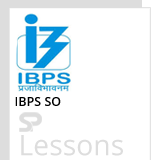 Introduction
Introduction
IBPS SO 2019 – Main Examination for the post of Law Officer, conducted in Online Mode, has: a duration of 45 minutes, a total of 60 questions, and a maximum score of 60 marks, and, consists of 1 section, namely: Professional Knowledge. There is a Negative marking in IBPS SO Main exam and 0.25 marks are deducted for each wrong answer. Each candidate will be required to obtain a minimum score in the test of Online Main examination and also secure sufficiently high scores to be considered to be shortlisted for interview. The below sections gives the detailed information about IBPS SO Law Officer Main Examination.
 Imp Dates
Imp Dates
| Event | Date |
|---|---|
| IBPS SO Notification 2019 Announcement | 05-11-2019 |
| IBPS SO Online Registration Starts From | 06-11-2019 |
| Last Date to Apply Online for IBPS SO | 26-11-2019 |
| Download of call letters for Online examination – Preliminary | 12 - 12 - 2019 |
| Closure of Call letter Download | 29-11-2019 |
| IBPS SO Preliminary Exam | [latex]{28}^{th}[/latex] and [latex]{29}^{th}[/latex] December 2019 |
| Result of IBPS SO Preliminary Exam | January 2020 |
| Download of call letters for Online examination – Mains | January 2020 |
| IBPS SO Mains Exam Date | [latex]{25}^{th}[/latex] January 2020 |
| Conduct of Interview | February 2020 |
| IBPS SO 2019-20 Final Result | April 2020 |
 Pattern
Pattern
The structure of the Examinations for the post of Law Officer which will be conducted online are as follows:
| Name of Test | Number of Questions | Maximum Marks | Medium of Exam | Duration |
|---|---|---|---|---|
| Professional Knowledge | 60 | 60 | English & Hindi | 45 minutes |
 Syllabus
Syllabus
Click Here - For Different Categories in IBPS SO Main Exam Syllabus
Note: Penalty for Wrong Answers.
There will be penalty for wrong answers marked in the Objective Tests. For each question for which a wrong answer has been given by the candidate one fourth of the marks assigned to that question will be deducted as penalty to arrive at corrected score. If a question is left blank, i.e. if no answer is marked by the candidate, there will be no penalty for that question.
 Samples
Samples
1. In which of the following, a term deposit receipt can be classified?
- A. not negotiable but transferable
B. transferable actionable claim
C. not transferable actionable claim
D. a demand liability e none of the above
- A. intangible asset
B. fictitious asset
C. current assets
D. fixed asset
E. not an asset
- A. Cannot exercise right of set-off against Harish’s account.
B. In case loan is recalled from Harish, the right of set-off can be exercised
C. Intervention of the court required
D. loan recall is not a necessary condition
E. None of the above
- A. apply to all partners
B. apply to firm’s account
C. not apply to firm’s account
D. not apply to any one.
E. a and c
- A. 1st January, 1964
B. 5th October, 1963
C. 1st January, 1965
D. 1st October, 1963
- A. One year
B. Two years
C. Six years
D. Twelve years
- A. Two years
B. Three years
C. Five years
D. Twelve years
- A. One year
B. Two years
C. Three years
D. Five years
- A. 120 days
B. 90 days
C. 60 days
D. 30 days





